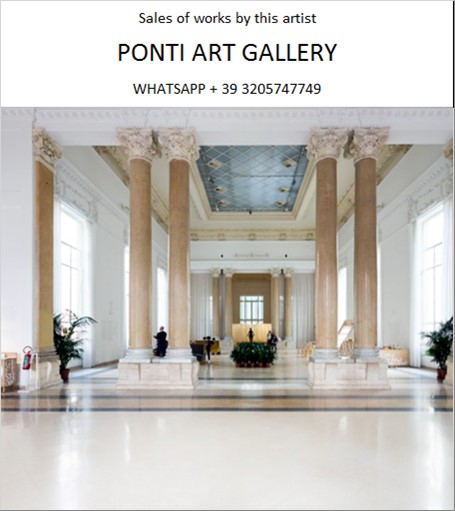Ponti Art Gallery is interested in buying and selling works
of art by this artist.

Julio Le-Parc Biography
Julio Le Parc is a distinguished Argentine-born artist, renowned for his pioneering contributions to both Op Art and Kinetic Art. Born on September 23, 1928, in Mendoza, Argentina, Le Parc grew up in a working-class family. His early life was marked by a move to Buenos Aires at the age of thirteen, where he juggled odd jobs while nurturing a burgeoning talent for drawing and painting. His artistic journey began in earnest when he prepared for the entrance exam to the Escuela Preparatoria de Bellas Artes, attending night school while working during the day.
Le Parc's formal art education commenced at the Escuela de Bellas Artes in Buenos Aires, where he was exposed to Argentina's avant-garde movements, including Arte Concreto-Invención and Spazialismo, inspired by one of his professors, Lucio Fontana. Despite his initial enthusiasm, Le Parc left the school in 1947, disillusioned with the education he received. He spent time traveling across Argentina, engaging with anarchist and Marxist groups, and exploring his own artistic and ideological stance.
In 1954, after a period of self-imposed marginalization, Le Parc reintegrated into society, taking a job at a state-sponsored theater and joining an independent experimental theater group. He re-enrolled at the Escuela Superior de Bellas Artes, where he became actively involved in student movements, advocating for educational reform and participating in protests against the repressive regime of Juan Perón.
Le Parc's artistic career took a decisive turn in 1958 when he won a scholarship from the French Cultural Service, which allowed him to move to Paris, the epicenter of the art world. This move was pivotal in shaping his future work. In Paris, he encountered influential figures such as Victor Vasarely and Georges Vantongerloo, and he began to experiment with visual instability, sequences, progressions, and the possibilities of light images.
In 1960, Le Parc co-founded the Groupe de Recherche d'Art Visuel (GRAV) with fellow artists including Hugo Demarco, F. García Miranda, Horacio García Rossi, F. Molnar, François Morellet, S. Moyano, Servanes, F. Sobrino, J. Stein, and Yvaral. GRAV was dedicated to exploring the interactive relationship between art and its audience, emphasizing the use of industrial, mechanical, and kinetic techniques. The group's work culminated in the 1968 Paris students' and workers' protests, where Le Parc was actively involved.
Le Parc's work is characterized by his experiments with geometric abstraction, light, and perception. He manipulates chromatic color palettes, negative space, and light to create immersive installations that challenge the viewer's perceptions and encourage active participation. His installations are in a state of perpetual motion and fluidity, transforming the gallery space into a labyrinthine game of reflecting shadows and light.
Throughout his career, Le Parc has received numerous accolades, including the Grand Prize for Painting at the 33rd Venice Biennale in 1966. Despite his success, he has remained a socially conscious artist, fighting against dictatorship in Latin America and advocating for human rights. In 1972, he made the unconventional decision to refuse a retrospective exhibition at the Musée d'Art Moderne de la Ville de Paris, choosing his path by flipping a coin.
Le Parc's artistic activities became less frequent in the 1970s, but his work continued to influence the art world. With a renewed interest in using light as a medium, his work has been brought to the attention of a wider public. He has been the subject of major retrospectives and his works are featured in prominent collections worldwide.
Today, Julio Le Parc lives and works in Paris, France. His legacy as a major figure in modern art history is secured by his innovative approach to art-making, his commitment to social and political issues, and his influence on subsequent generations of artists. His work continues to inspire and provoke, inviting viewers to reconsider their relationship with art and the spaces it inhabits.
Julio Le-Parc Quotes and Sales
of Works
Ponti Art Gallery selects and deals with paintings by the
artist. Upon request, we provide free estimates and
evaluations, communicate prices, quotations, and current
market values.
If you are interested in BUYING or SELLING works by the
artist, contact us immediately.
If you wish to sell or receive an evaluation of the
works:
Send us a frontal photo of the painting, one of the back,
and one of the signature. Also, indicate the dimensions of
the work. Inform us about the purchase origin of the work
and any kind of available documentation (purchase
receipts, certificates of authenticity, publications). One
of our operators will respond to you on the same day. We
guarantee maximum confidentiality and extreme
professionalism.
If you wish to purchase works by the painter: Contact us
and let us know your request. We will inform you about the
available works. We also offer the possibility to
subscribe to our NEWSLETTER, through which you will be
informed at the beginning of each month about the latest
acquisitions of the art gallery.
You can send us pictures of the work:
